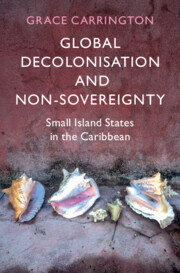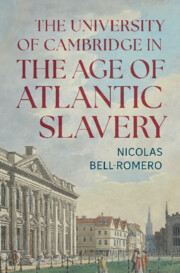Refine search
Actions for selected content:
264 results
1 - The Limit of Afro-Mexico
- from Part I - Freedom and Colonial Legacies
-
-
- Book:
- Afro-Mexican Lives in the Long Nineteenth Century
- Published online:
- 20 November 2025
- Print publication:
- 04 December 2025, pp 35-62
-
- Chapter
- Export citation
6 - The Black Atlantic, Slave Narratives, and Empire
- from Part I - Early Intimations and Literary Genres: 1500–1800
-
-
- Book:
- The Cambridge Companion to British Literature and Empire
- Published online:
- 20 November 2025
- Print publication:
- 04 December 2025, pp 93-106
-
- Chapter
- Export citation
19 - Beyond the Empire
- from Part IV - Pathways and Legacies: 1945–2020
-
-
- Book:
- The Cambridge Companion to British Literature and Empire
- Published online:
- 20 November 2025
- Print publication:
- 04 December 2025, pp 279-292
-
- Chapter
- Export citation
Introduction
-
- Book:
- The Making of Brazilian Amazonian Societies
- Published online:
- 14 November 2025
- Print publication:
- 20 November 2025, pp 1-36
-
- Chapter
- Export citation
Case 4.1 - What’s in It for Us?
- from Part IV - Case Studies in Macro-Level Practice
-
-
- Book:
- Critical Race Theory in Action
- Published online:
- 25 October 2025
- Print publication:
- 13 November 2025, pp 125-134
-
- Chapter
- Export citation
Chapter 21 - Print Networks in the Black Atlantic World, c. 1920–1960
- from Part IV - Worlds of Print
-
-
- Book:
- African Literature in Transition
- Published online:
- 23 October 2025
- Print publication:
- 06 November 2025, pp 409-426
-
- Chapter
- Export citation
Starring Esteban Montejo as Himself: Featuring the African Inspirations of the ‘Audiovisual Interface’, 1975/1812
-
- Journal:
- Journal of Latin American Studies , First View
- Published online by Cambridge University Press:
- 03 November 2025, pp. 1-33
-
- Article
-
- You have access
- Open access
- HTML
- Export citation
1 - ‘The principal ingredient necessary to form a good planter’: Education and the Making of a Transatlantic Elite
-
- Book:
- The University of Cambridge in the Age of Atlantic Slavery
- Published online:
- 12 September 2025
- Print publication:
- 30 October 2025, pp 19-48
-
- Chapter
-
- You have access
- Open access
- HTML
- Export citation
3 - ‘The Glory of their times’: Natural Philosophy, the Law, and the Spoils of Empire
-
- Book:
- The University of Cambridge in the Age of Atlantic Slavery
- Published online:
- 12 September 2025
- Print publication:
- 30 October 2025, pp 76-103
-
- Chapter
-
- You have access
- Open access
- HTML
- Export citation
Introduction
-
- Book:
- The University of Cambridge in the Age of Atlantic Slavery
- Published online:
- 12 September 2025
- Print publication:
- 30 October 2025, pp 1-18
-
- Chapter
-
- You have access
- Open access
- HTML
- Export citation
A look at intercultural archaeology from the Colombian Caribbean
-
- Journal:
- Archaeological Dialogues / Volume 31 / Issue 1 / June 2024
- Published online by Cambridge University Press:
- 23 October 2025, pp. 31-34
-
- Article
-
- You have access
- Open access
- HTML
- Export citation
Chapter 4 - Stereophonic Boundaries
-
- Book:
- American Modernism and the Cartographic Imagination
- Published online:
- 09 October 2025
- Print publication:
- 23 October 2025, pp 148-182
-
- Chapter
- Export citation
Chapter 10 - The (In)significance of Rum
- from Part III - Applications
-
-
- Book:
- Commodities and Literature
- Published online:
- 14 October 2025
- Print publication:
- 09 October 2025, pp 179-193
-
- Chapter
- Export citation
Chapter 13 - Water in World Literature
- from Part III - Applications
-
-
- Book:
- Commodities and Literature
- Published online:
- 14 October 2025
- Print publication:
- 09 October 2025, pp 228-243
-
- Chapter
- Export citation

Global Decolonisation and Non-Sovereignty
- Small Island States in the Caribbean
-
- Published online:
- 16 September 2025
- Print publication:
- 31 July 2025

The University of Cambridge in the Age of Atlantic Slavery
-
- Published online:
- 12 September 2025
- Print publication:
- 30 October 2025
-
- Book
-
- You have access
- Open access
- Export citation

Black Catholic Worlds
- Religious Geographies of Eighteenth-Century Afro-Colombia
-
- Published online:
- 28 August 2025
- Print publication:
- 11 September 2025
Building belonging and evoking identity through bodily adornment: pendants from the Ortiz site, south-western Puerto Rico
-
- Journal:
- Antiquity , First View
- Published online by Cambridge University Press:
- 27 August 2025, pp. 1-17
-
- Article
-
- You have access
- Open access
- HTML
- Export citation
Medusozoans of Cuba (Cnidaria): an update
-
- Journal:
- Journal of the Marine Biological Association of the United Kingdom / Volume 105 / 2025
- Published online by Cambridge University Press:
- 19 August 2025, e88
-
- Article
- Export citation
3 - Language Ideologies and the Creole Context
- from Part I - Theoretical Background and Setting
-
- Book:
- Liquid Languages
- Published online:
- 28 July 2025
- Print publication:
- 14 August 2025, pp 38-53
-
- Chapter
- Export citation
